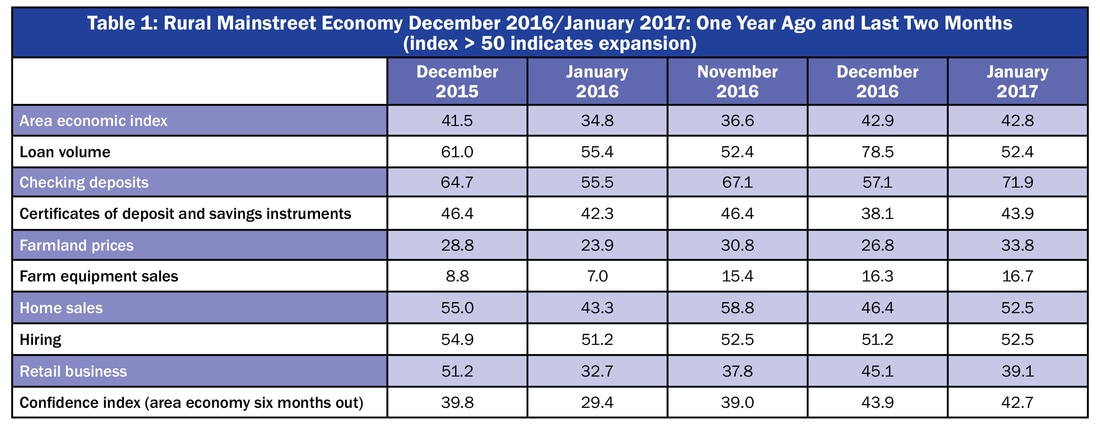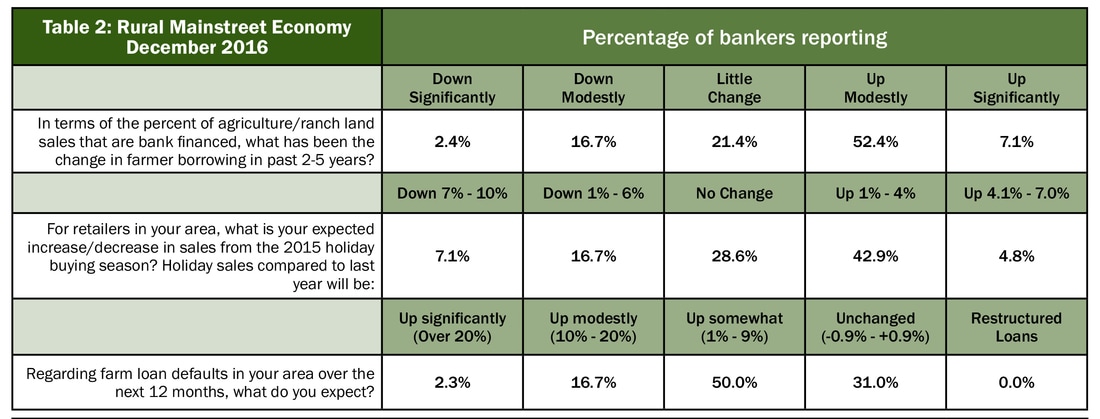- For a 16th straight month, the Rural Mainstreet Index remained below growth neutral though the index advanced to its highest level since June 2016.
- Farmland prices declined for the 37th straight month.
- Bank CEOs expect loan defaults to rise by 5.6 percent over the next 12 months. This estimate is up slightly from 5.4 percent recorded in July of this year.
- Bankers expect holiday sales for Rural Mainstreet retailers to expand by a scant 0.4 percent over 2015 levels.
- States with December Rural Mainstreet expansions: Iowa, Nebraska, and South Dakota; States with December Rural Mainstreet contractions: Colorado, Kansas, Illinois, Missouri, North Dakota and Wyoming, and Minnesota.
OMAHA, Neb. (Dec. 15, 2016) – The Creighton University Rural Mainstreet Index remained weak with a reading below growth neutral for the 16th straight month, according to the monthly survey of bank CEOs in rural areas of a 10-state region dependent on agriculture and/or energy.
Overall: The index, which ranges between 0 and 100 rose to 42.9, its highest level since June of this year, and up from November’s 36.6.
“Weak farm commodity prices continue to slam Rural Mainstreet economies. Over the past 12 months, livestock commodity prices have tumbled by 19.0 percent and grain commodity prices have slumped by 11.5 percent. The economic fallout from this price weakness continues to push growth into negative territory for seven of the 10 states in the region,” said Ernie Goss, Jack A. MacAllister Chair in Regional Economics at Creighton University's Heider College of Business.
States trending higher: Iowa, Nebraska, and South Dakota; States trending lower: Colorado, Kansas, Illinois, Minnesota, Missouri, North Dakota and Wyoming.
The December farm equipment-sales index increased to 16.3 from 15.4 in November.
“Since July 2013, weakness in farm income and low agricultural commodity prices continue to restrain the sale of agricultural equipment across the region. This is having a significant and negative impact on both farm equipment dealers and agricultural equipment manufacturers across the region,” said Goss.
Banking: Borrowing by farmers remains strong as the December loan-volume index jumped to 78.5 from last month’s 52.4. The checking-deposit index declined to a still solid 57.1 from 67.1 in November, while the index for certificates of deposit and other savings instruments sank to 38.1 from 46.4 in November.
This month bankers were asked to estimate farm loan default rates. Bankers expect loan defaults to expand by 5.6 percent over the next 12 months. “Expected loan default rates have changed little during 2016,” said Goss.
Hiring: The job gauge dipped to 51.2 from November’s 52.5. For the region, Rural Mainstreet employment is down by 0.6 percent over the past 12 months. Over the same period of time, urban employment for the region expanded by 1.2 percent.
Confidence: The confidence index, which reflects expectations for the economy six months out, rose to 43.9 from 39.0 in November indicating a continued pessimistic outlook among bankers. “Until agricultural commodity prices begin to trend higher, I expect banker’s economic outlook to remain weak,” said Goss.
Home and Retail Sales: Home sales moved lower for the Rural Mainstreet economy for December with a reading of 46.4 from November’s healthy 58.8. The December retail-sales index increased to 45.1 from November’s 37.8.
Bank CEOs expect lackluster holiday sales growth. On average, Rural Mainstreet bankers expect a 0.4 percent increase from 2015 holiday retail sales levels.
This survey represents an early snapshot of the economy of rural agriculturally and energy-dependent portions of the nation. The Rural Mainstreet Index (RMI) is a unique index covering 10 regional states, focusing on approximately 200 rural communities with an average population of 1,300. It gives the most current real-time analysis of the rural economy. Goss and Bill McQuillan, former chairman of the Independent Community Banks of America, created the monthly economic survey in 2005.
| Colorado: Colorado’s Rural Mainstreet Index (RMI) plummeted to 24.9 from 51.2 in November. The farmland and ranchland-price index fell to 25.5 from November’s 48.5. Colorado’s hiring index for December rose to 55.2 from November’s 53.9. Colorado job growth over the last 12 months; Colorado Rural Mainstreet, -1.2 percent; Urban Colorado, +3 percent. Illinois: The December RMI for Illinois improved 34.2 from 26.6 in November. The farmland-price index sank to a frail 17.9 from November’s 26.8. The state’s new-hiring index climbed to 52.4 from last month’s 51.5. Illinois job growth over the last 12 months; Illinois Rural Mainstreet, -0.6 percent; Urban Illinois +0.7 percent. Iowa: The December RMI for Iowa fell to 63.5, a regional high, from 72.1 in November, also a regional high. Iowa’s farmland-price index for December slumped to 49.3 from 56.6 in November. Iowa’s new-hiring index for December slipped to a still strong 63.9 from November’s 66.2. Iowa job growth over the last 12 months; Iowa Rural Mainstreet, +1.4 percent; Urban Iowa, +0.9 percent. Kansas: The Kansas RMI for December slumped to 16.0 from November’s 22.5. The state’s farmland-price index increased to a weak 41.2 from 25.6 in November. The new-hiring index for Kansas slipped to 47.9 from 49.1 in December. Kansas job growth over the last 12 months; Kansas Rural Mainstreet, -1.8 percent; Urban Kansas, +0.2 percent. Minnesota: The December RMI for Minnesota expanded to a weak 41.7 from November’s 24.4. Minnesota’s farmland-price index dipped to 24.0 from 27.7 in November. The new-hiring index for the state slipped to a still solid 54.7 from last month’s 55.7. Minnesota job growth over the last 12 months; Minnesota Rural Mainstreet, -0.1 percent; Urban Minnesota +1.3 percent. | Missouri: The December RMI for Missouri decreased to 27.1 from 27.6 in November. The farmland-price index increased to 37.9 from November’s 20.9. Missouri’s new-hiring index rose to 39.6 from 29.1 in November. Missouri job growth over the last 12 months; Missouri Rural Mainstreet, -1.1 percent; Urban Missouri +2 percent. Nebraska: The Nebraska RMI for December advanced to 51.4 from November’s 37.9. The state’s farmland-price index tumbled to 29.6 from November’s 45.5. Nebraska’s new-hiring index declined to a healthy 56.7 from 59.5 in November. Nebraska job growth over the last 12 months; Nebraska Rural Mainstreet, no change; Urban Nebraska, +0.4 percent. North Dakota: The North Dakota RMI for December expanded to a very frail 38.9 from November’s 28.9. The farmland-price index increased to 29.9 from November’s 27.3. North Dakota’s new-hiring index improved to 32.1 from 30.7 in November. North Dakota job growth over the last 12 months; North Dakota Rural Mainstreet, -5.1 percent; Urban North Dakota, +0.5 percent. South Dakota: The December RMI for South Dakota soared to 60.5 from November’s 47.1. The farmland-price index sank to 39.7 from November’s 45.5. South Dakota's new-hiring index slipped to a healthy 60.4 from November’s even stronger 62.2. South Dakota job growth over the last 12 months; South Dakota Rural Mainstreet, +1.2 percent; Urban South Dakota, +3.4 percent. Wyoming: The December RMI for Wyoming increased to a feeble 30.6 from 19.8 in November. The December farmland and ranchland-price index increased to 35.6 from November’s 23.8. Wyoming’s new-hiring index slipped to 43.0 from November’s 45.4. Wyoming job growth over the last 12 months; Wyoming Rural Mainstreet, -3.2 percent; Urban Wyoming, -4.5 percent. |



 RSS Feed
RSS Feed